On Dogs: Who Rescued Who?
Fostering, rescuing, and finding a best friend with Geetanjali Moorthy
For National Pet Month/Dog Rescue Day, I spoke with animal lover Geetanjali Moorthy, a mom of two girls who makes a mean butter chicken and knows the name of every dog in the neighborhood.
Our conversation took place in Geet’s office while her rescue dog Cookie slept at our feet and occasionally sought chin scratches and belly rubs.
How did you get involved with fostering?
During COVID, when everybody was looking to adopt puppies, I applied to six rescues to adopt or foster. Five of those six said no because we had no enclosed outdoor space. Eventually, I reached out to the rescue where we got Cookie, 4 Dogs Farm Rescue, which is run by a phenomenal lady.
Her families foster the dogs for at least a month so they are completely healed, fully vetted, and loved. I saw Cookie's picture, and there was something about her. I was going through a rough time and wanted to bring home a dog who needed healing.
When they found her, she'd been hit by a car and also suffered a traumatic pregnancy. She came to us and was so scared. Within minutes of being in our home, my youngest daughter was sitting on the floor and Cookie just went and collapsed on her lap.
At first, she followed me everywhere, very unsure. Is this temporary? Am I going to be here forever? She had some issues. But we dealt with all of them. It took almost two years to get her to feel safe.
The 333 rule* matters. I kept a close eye on that, and it took a while. *(The 3-3-3 rule is a guideline for transitioning a rescue dog—the first three days are for adjusting to new surroundings, the next three weeks for training and bonding, and the first three months for continued socialization and training.) (add link)
So that's where I got the idea of only doing rescues. I have the bandwidth. We have financial stability. There are enough pups that really need homes, and there's nothing wrong with them.
When we moved to our house, we had gone through training and understood what it meant to have an animal from a rescue that had suffered some kind of trauma. It was eye-opening.
The day Cookie came home, I sat down next to her and made her a promise: You're here, you're going to stay, and I'll help you heal.
And that was it. So that's what started it.
What foster program do you work with?
It’s called CalPaws K9 Rescue. They vet applicants and do a house visit. They can even do it virtually. I showed them the space where we'd house the dogs and the options during the day if we were gone. Will the dog be crated? Will it have its own space? Will it be outside? I deeply appreciated how particular they are because they need assurance that they're giving you a pup who will be in a safe space.
You agree to at least one adoption event a month. You can either drop off and have a handler or do it yourself. I prefer to do it because they know me, and that sets them up for success.
I'm still really new to this. Some fosters have been doing this for decades. What's great about this rescue is you have a village. One person will answer questions about a puppy, while another will know about big dominating dogs, or how to interact with smaller dogs.
It's not just about giving you all of the physical supplies you need; it's about the wealth of knowledge they provide. A good rescue will provide the framework you need to succeed as a foster. The rest is dependent on you.
Tell me about the dogs you've fostered.
We've had five so far.
Our introduction to fostering was a 10-week-old pup. She was feisty and all puppy, hanging off Cookie's jowls. Cookie was really patient with that.
Some come straight from the shelter. Two came from a homeless encampment, where they were abused. Those pups were really rambunctious. They typically wouldn't have been together, but there was no option. They had to be rescued.
Then there was Herman. Everybody said, "He's a Malinois, and they need a lot of activity." But he was just a big love. He was half-cat, I think. He just liked to be outside sunbathing. Otherwise, he was a big lunk sleeping on the couch.
The last guy we had, Zacai, was a 90-pound German Shepherd. He did not like men, and it was very difficult for him. He'd start barking any time my husband came close. It wasn't aggression; it was fear.
You learn to consider all of these things because the bottom line is it needs to be a success for the dogs. We had Zacai for just four days because it was unfair to him to limit his interactions. I'm okay to say, "Hey, this isn't working." I'm failing the dog if I'm not able to give him a safe environment. Our foster can find someplace that's going to work out better.
I stay in touch with the people who adopted our fosters.
One of the puppies went to a home with three girls and an older dog, who was also rambunctious, but she did really well. Her sibling went to a home with an older dog—they hiked a lot and traveled, so he went to the perfect home as well.
Zacai went to an adoption event. A family came in looking to adopt a puppy, but he walked up to the daughter and just put his head on her lap. He went home with them, and he's happy as a clam.
It's really nice to see that.
How long do you typically foster them?
It depends. The longest was three weeks. But some, especially older dogs, can take much longer.
How has fostering impacted your family?
In the beginning, we sat down as a family and talked about it and what it entailed. A lot of it falls on my shoulders. But I'm okay with that.
It's a lot of work. I won't deny it. When the dogs leave, I'm exhausted. It's physical. It's mental. It's everything.
I'm so happy that the kids are exposed to this and gaining an understanding of dogs and animals—body language and animal behavior. It's a life lesson I think will hold them in good stead.
With every pup that comes home, the kids immediately engage. I need them to do that because the dogs also have to be exposed to little humans. That's one of the things that's really important when you're setting a dog up to be adopted. People want a family-oriented dog.
My kids are trained to interact with dogs. Engage from the front, always maintain eye contact, and be very slow in how you engage. If you want to pet it, make sure the dog looks comfortable.
As a family, we appreciate all that we have and how lucky we are. When we look at Cookie and where she came from and where she is today, she's lucky, too. I think that's what the kids understand more than anything else.
Each dog affects them deeply. The little one will ask me questions at bedtime, "Mama, do you think that that dog is okay? How is that pup doing?"
In what way do you hope your involvement with fostering impacts others?
Every dog is like a human, with different personalities and different things that shine within them. A lot of mental energy goes into managing these dogs, but I don't feel it's wasted because everything you equip them with will help them do better as family pets and find a home.
When I see a dog flourishing and realize I've saved a life, it's enormously rewarding.
What advice do you have for someone who's considering fostering?
You have to account for many things when you bring these animals into your home.
First of all, there's that fear of them being aggressive. Of all the dogs I've brought home, not one has shown aggression. They trust you the second you bring them into your house. The only thing they need is for you to be gentle and have patience with them.
As a foster, your job is to ensure that you're equipping these dogs with everything they need to be successful when they go to a home. You need to ensure they have basic training—they must be potty trained, know how to walk on a leash, and be aware of other dogs and other animals. These are just my rules. It varies.
Everything happens in steps. For the first couple of hours, you're trying to figure out what the dynamic is. What's comfortable for this animal? They've come from a situation where they're in cages in shelters, where there's a lot of noise. Allow them that space to decompress. To just be.
Slowly introduce them to everyday life in a house. Get them used to the noises and interactions around them, but also give them space. Once they start feeling comfortable, it will be easier to start training them.
Do you have the space for it? Do you have the mental bandwidth? Do you have the emotional bandwidth? Because sometimes it's really hard to let them go. Especially when you have kids who fall in love with puppies, it gets hard to say no.
How do you handle that?
I'm pretty clinical about it. Maybe we can get a second dog someday. But my goal right now is to help as many dogs as I can to find homes—that's important to me.
Who or what inspires you?
Having a hands-on impact. Trying to heal an animal—showing them that there's still a safe space, that there's still humanity. There are still good people.
This newsletter and my forthcoming memoir deal in matters of the heart, so I'll close each interview with three questions about the heart.
What fills your heart with joy?
Books and animals. Give me a good book and a dog and I'm happy.
What breaks your heart?
Seeing an animal being mistreated. There's no voice other than fearful barking. It shatters me.
The last question needs a little backstory. When I taught kindergarten, we did this project where the kids made maps of their hearts. They cut out tagboard and drew important "special" things in their heart. My oldest put our ice cream truck driver in his. I'll never forget. His teacher said, "I don't know if I should tell you this. The grandparents didn't make it, but the ice cream man did."
So I'd like to close with this question.
In the map of your heart, name a person, a place, and a thing that would be in it. Why?
Definitely my husband. We've been together for 26 years. I've known him since we were nine. So, definitely him.
And a place?
Sea Ranch is very beautiful. My husband and I grew up in seaside towns, so the ocean is very grounding for both of us. There's a little outlook, and we just climb the rocks, sit, look out, and listen to the sound of the ocean.
And a thing? It can be anything.
The sound of the ocean, which is why I love Sea Ranch.
Thank you Geet, for sharing your heart with me—and so many dogs!
A book and a song (and a dedication):
Dog Medicine: How My Dog Saved Me From Myself by Julie Barton
A heartfelt story of how one dog’s unconditional love and devotion brought a young woman back from the depths of depression. I savored it from beginning to end and felt my heart heal, break, and heal again right along with the author.
“In that moment, of course, I knew. There he was. I hadn’t been forced to choose; I’d been chosen. I picked him up and he licked my nose. He smelled like dirt and metal and wet dog. My dog had found me.”
― Julie Barton, Dog Medicine
"We’re Going To Be Friends" by Jack Johnson
Jack Johnson covered this song (originally by The White Stripes) for the movie Curious George. It’s about a burgeoning friendship among schoolmates, but could just as easily tell the story of walking through life with a four-legged bestie.
Listen here.
The Heart of the Matter:
❥ Thinking about fostering? Start with a short-term placement or an easygoing pup.
❥ Ask yourself: Do you have the space for it? Do you have the mental and emotional bandwidth?
❥ Remember that rescues have had a hard start. They need time to adjust to finally being home. Be patient and follow the 3-3-3 rule.
❥ In 2024, about 2.9 million dogs entered shelters. Of those, 2 million were adopted and 334,000 were euthanized. Just over half the shelters in the US are no-kill.
❥ The rate of adoption can’t keep up with the rate of surrender (most are strays), leaving two million shelter dogs waiting for their forever families. Could it be you?
❥ Not looking to adopt? Consider fostering or volunteering at your local animal shelter. There are lots of ways to support them to fit your bandwidth.
You might even get to walk a gorgeous girl like Luna for a “Doggie Day Out.” 10/10 recommend. (I gave her an A+ on her report card.) She’s available to adopt!
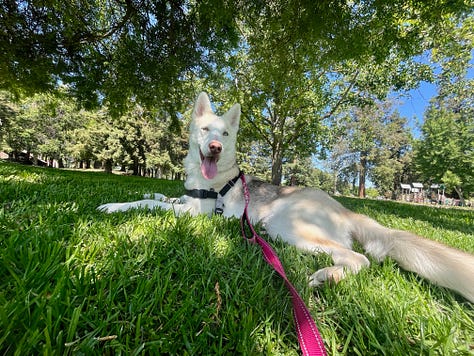
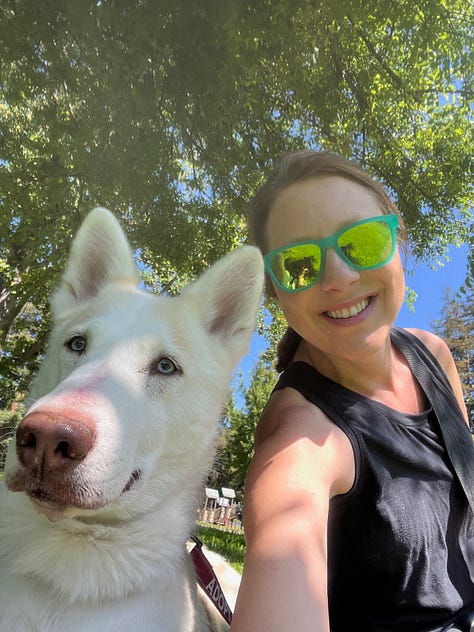
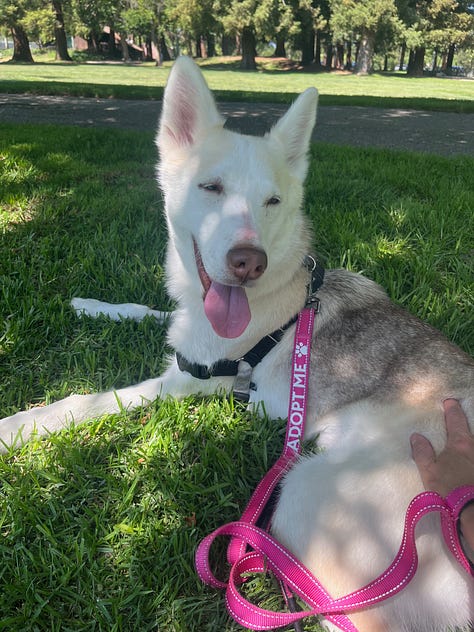
A Dedication:
(CW: Dog Loss) Last month, we abruptly said goodbye to our beloved best boy, Stanley. The end is so sad, so I’ll share the beginning—how he came to be ours for 10 glorious years. On the drive to meet another rescue, Stanley’s picture popped up on another site and I passed my phone around the car. We had exactly one exit to change course. “That’s our dog,” we said as we took the exit and never looked back.
Stanley, like most rescues, had a rocky start. After he recovered from kennel cough, he learned how to play (thanks to the OG Scruffamutt Marley), how to walk from one surface (carpet) to another (hardwood), and how to trust. But he was always a master cuddler!
We rescued him, and he spent his life rescuing us right back—with his silly spins, devoted lap-flopping, and emotional support ears. Stanley, Tan-Tan, Staney-Tani-Coco-Pop, you will always be my favorite kitchen dancing partner. My lap is empty without you, but I’m eternally grateful my heartmap led me to you. (Now, go do some zoomies with Marley)🖤🐾
Some Rescues I Love:
Family Dog Rescue (Stanley)
Doggie Protective Services (Marley)
Copper’s Dream (Hope)
Silicon Valley Humane Society (Pumpkin)
Jacque Gorelick is an essayist who writes about family, motherhood, health, and estrangement. Her debut memoir, Map of a Heart: A Memoir of Love, Loss, and Finding the Way Home, is forthcoming with Vine Leaves Press (February 2026). You can find more about her work here.
Thanks so much for spending part of your day with me.
❤️ Jacque


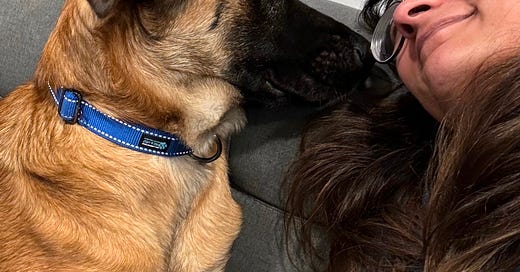



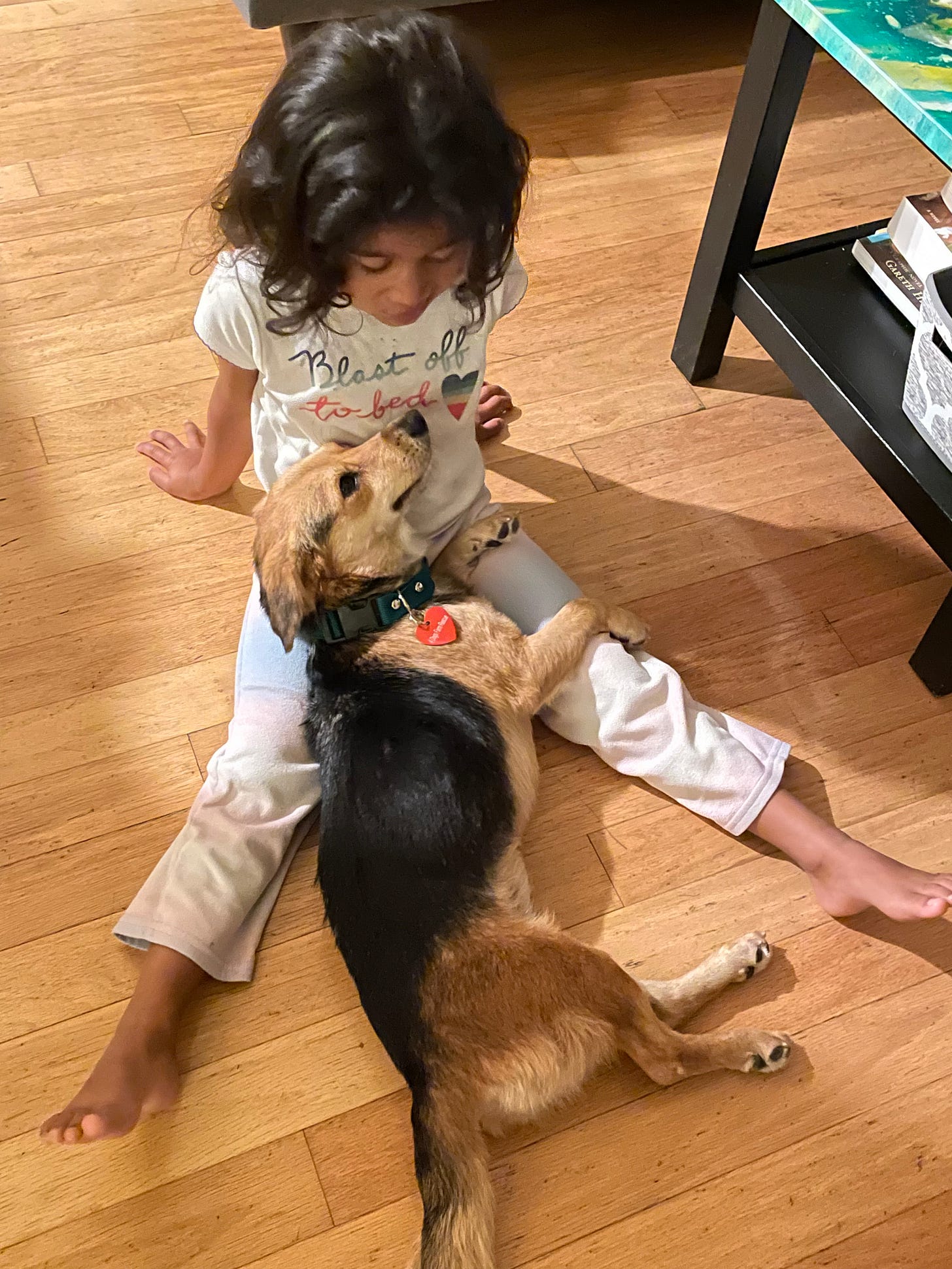
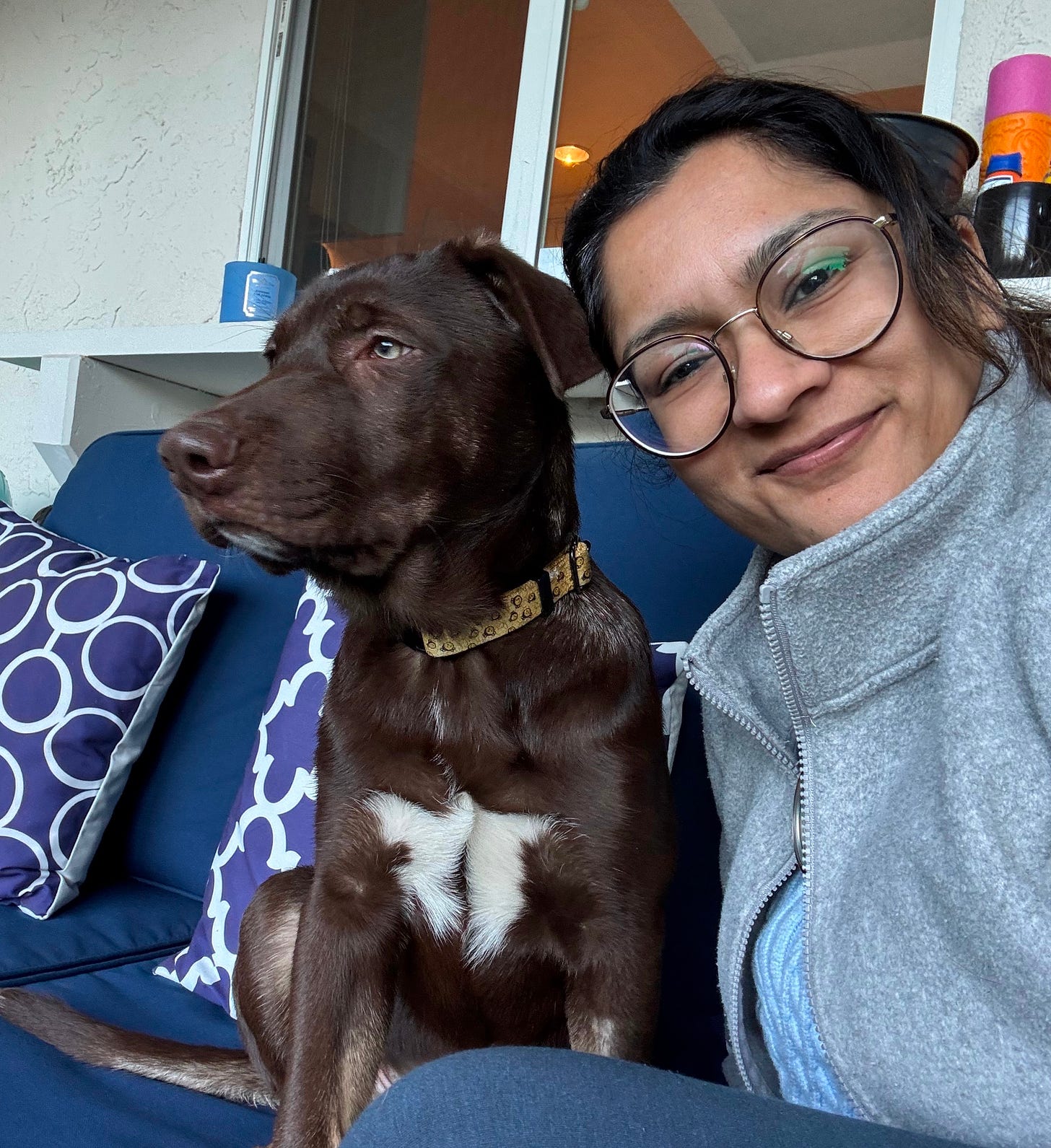
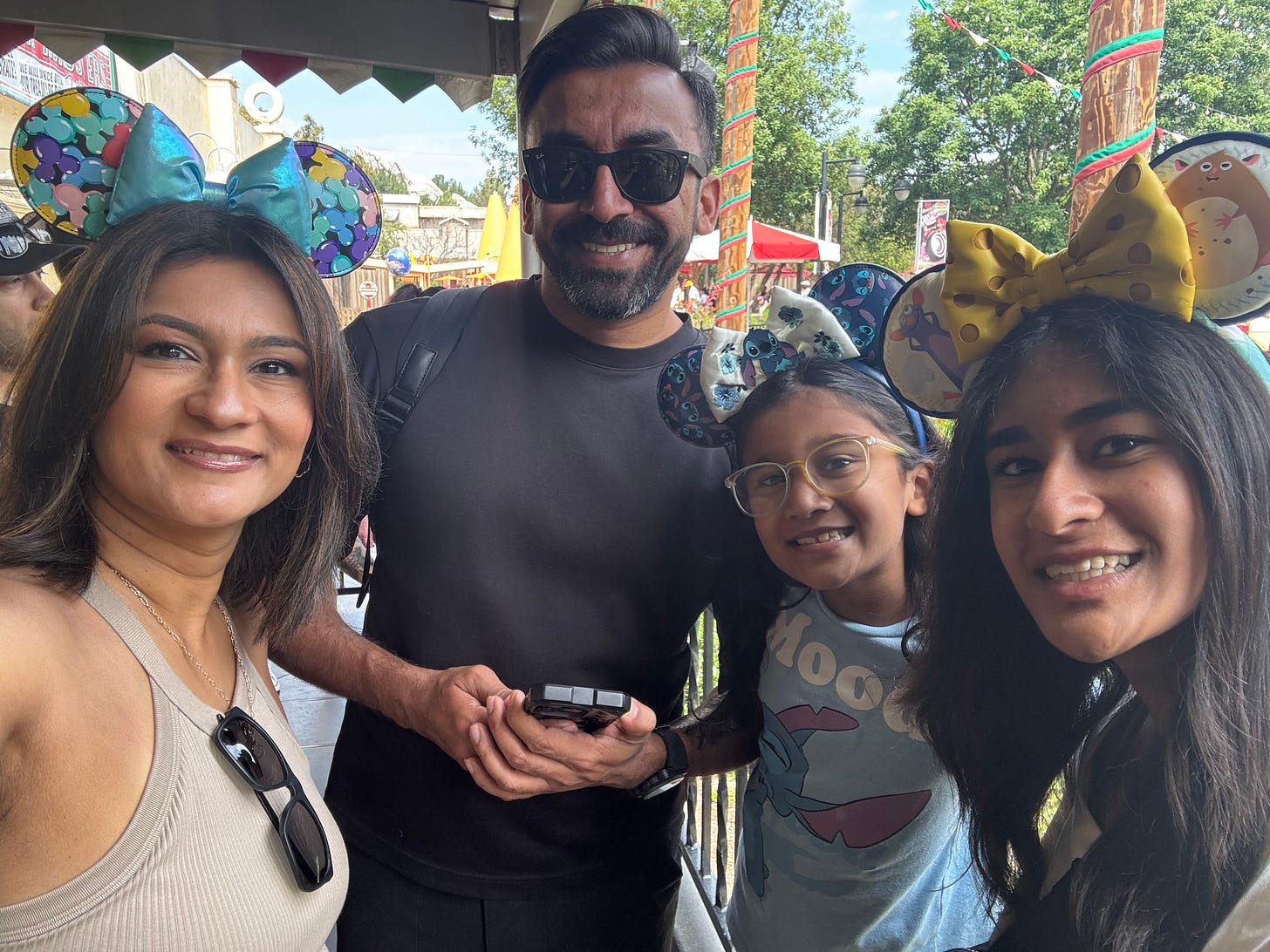
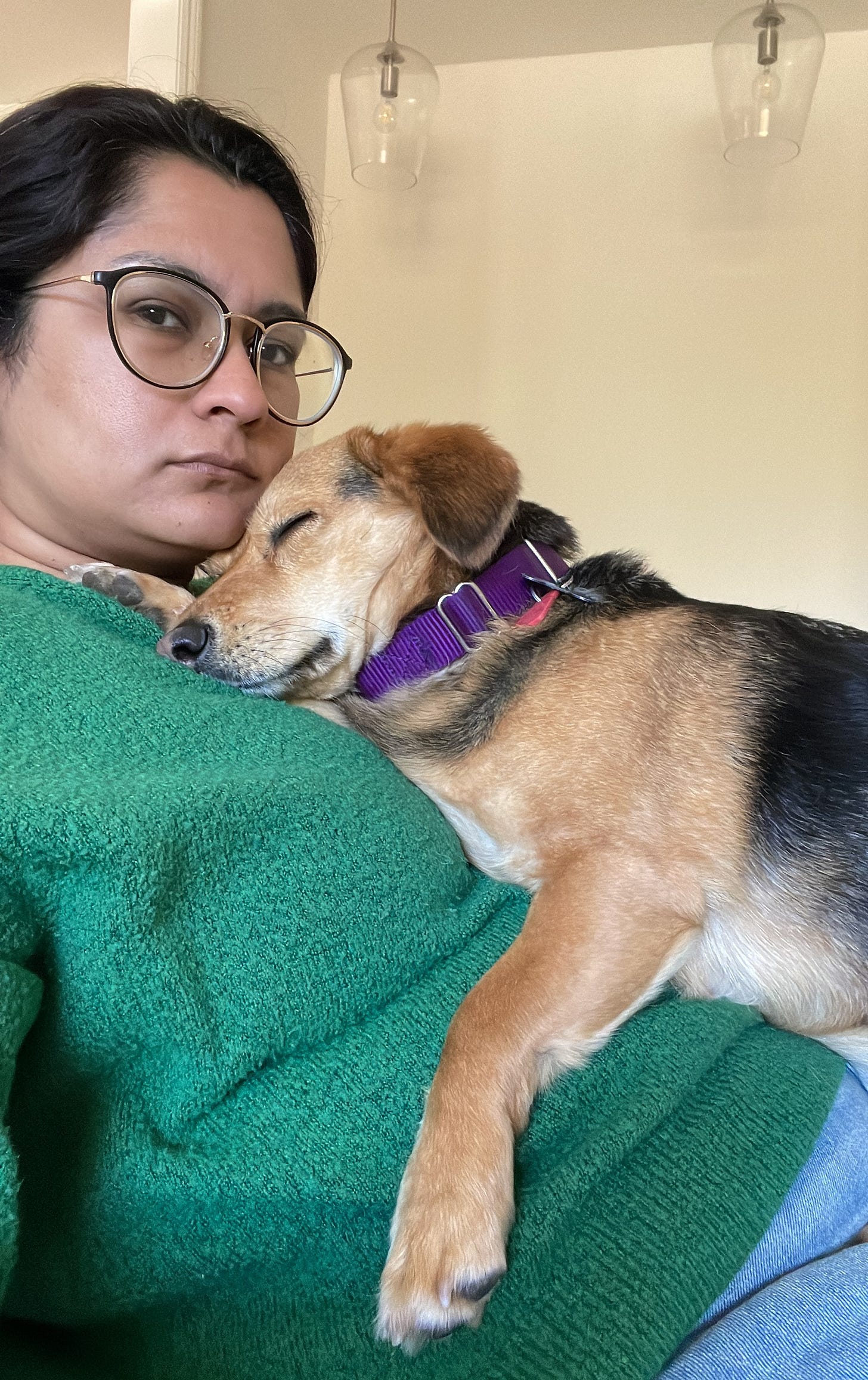
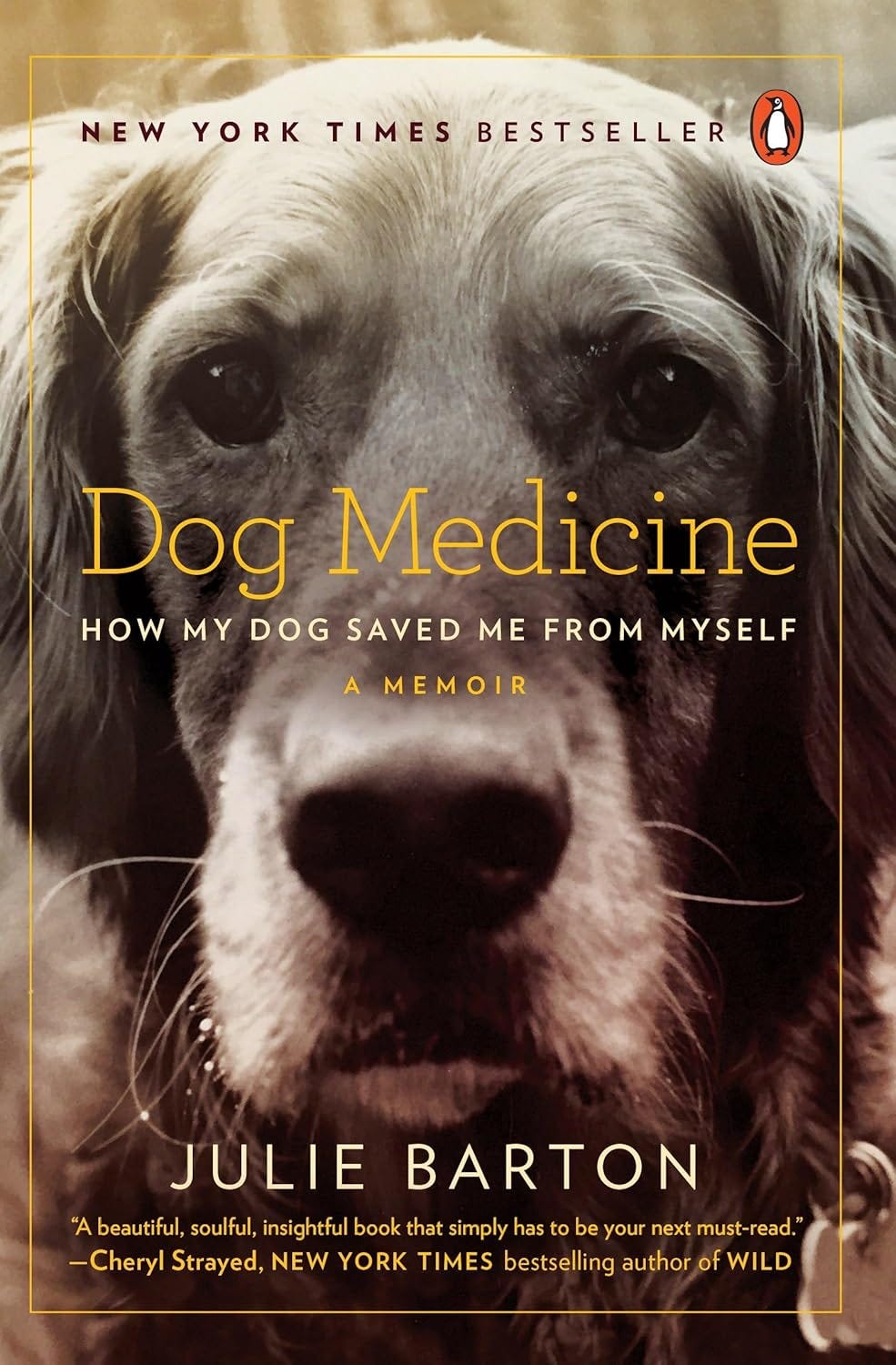

Having recently said goodbye to our beloved Sugarpup, these stories leave me filled with gratitude for the 15 years we had with our sweet girl. The rescue was Operation Paws for Homes and they are still doing the work. Sugar was 3 years old when she came to us as a foster. Our home feels so empty without her.
Thank you for this, truly. ❤️Stanley was loved so much.